ZTE R8882S1700 UMTS and LTE Remote Radio Unit User Manual ZXSDR R8882 Product Description
ZTE Corporation UMTS and LTE Remote Radio Unit ZXSDR R8882 Product Description
ZTE >
Contents
- 1. User manual
- 2. User manual 1
- 3. User manual 2
- 4. User manual 3
- 5. User manual 4
User manual 1
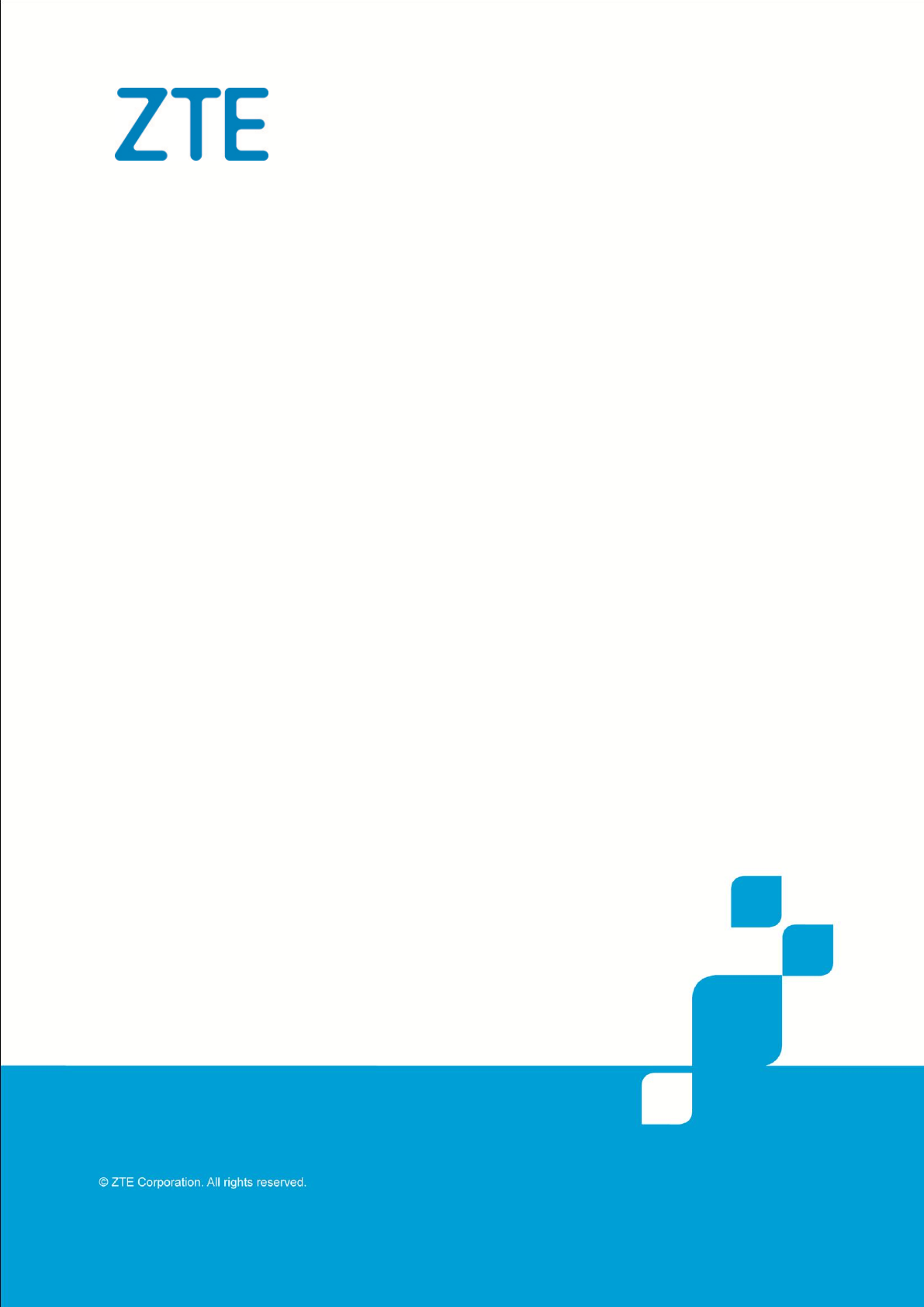
ZXSDR R8882 Product Description
UniRAN15/GUL Multi-Mode
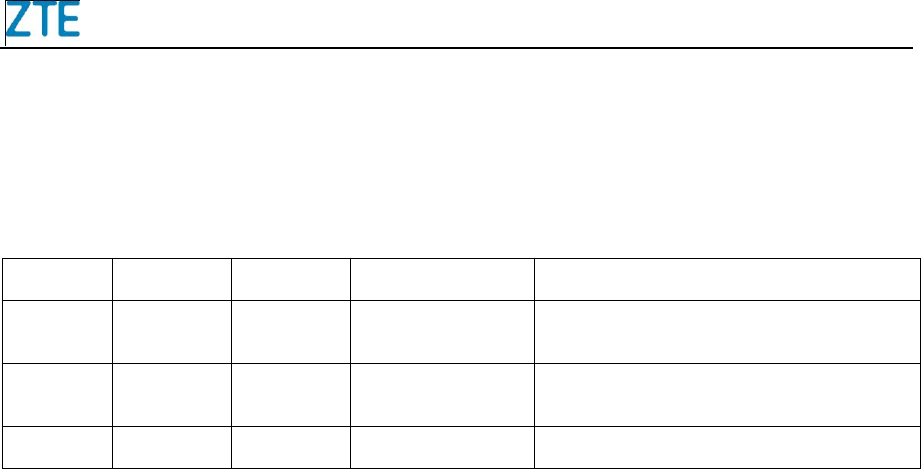
ZXSDR R8882 Product Description
ZTE Confidential & Proprietary 1
ZXSDR R8882 Product Description
Version
Date
Author
Reviewer
Notes
V1.00
2015-02-12
Yang Lisha,
Guo Qing
Chen Yong, Yang
Xu, Li Sijun
First release, information of GSM, UMTS and
FDD LTE Multi-Mode are included
V1.10
2015-04-15
Yang Lisha,
Guo Qing
Chen Yong, Yang
Xu, Li Sijun
Modified the cover and the header logo,
introduce U/L dual-mode in 1700 spectrum
© 2015 ZTE Corporation. All rights reserved.
ZTE CONFIDENTIAL: This document contains proprietary information of ZTE and is not to be disclosed or used
without the prior written permission of ZTE.
Due to update and improvement of ZTE products and technologies, information in this document is subjected to
change without notice.

ZXSDR R8882 Product Description
2 ZTE Confidential & Proprietary
TABLE OF CONTENTS
1 Overview ............................................................................................................ 4
1.1 Introduction .......................................................................................................... 4
1.2 Benefits ................................................................................................................ 4
1.3 Application Scenarios .......................................................................................... 5
2 Product Architecture ......................................................................................... 5
2.1 Physical Structure ................................................................................................ 5
2.2 Hardware Structure .............................................................................................. 6
2.2.1 QTR/DTR ............................................................................................................. 7
2.2.2 DFL ...................................................................................................................... 8
2.2.3 PA ........................................................................................................................ 9
2.2.4 RPDC .................................................................................................................. 9
2.2.5 PIB ..................................................................................................................... 10
2.3 External Interfaces ............................................................................................. 10
2.4 Software Architecture ......................................................................................... 11
2.5 Functionality ....................................................................................................... 12
3 Technical Specifications ................................................................................. 13
3.1 Physical Indices ................................................................................................. 13
3.2 Performance Indices .......................................................................................... 14
3.2.1 Operation Frequency Band ................................................................................ 14
3.2.2 Capacity ............................................................................................................. 15
3.2.3 Static Receiving Sensitivity ................................................................................ 15
3.2.4 TOC Output Power ............................................................................................ 16
3.3 Power Indices .................................................................................................... 17
3.3.1 Power Supply ..................................................................................................... 17
3.3.2 Power Consumption ........................................................................................... 17
3.4 Transmission ..................................................................................................... 19
3.5 Working Environment ......................................................................................... 19
3.6 Electromagnetic Compatibility ............................................................................ 20
3.7 Reliability ........................................................................................................... 20
4 Installation ....................................................................................................... 20
5 Configurations ................................................................................................. 21
6 Abbreviation .................................................................................................... 22

ZXSDR R8882 Product Description
ZTE Confidential & Proprietary 3
FIGURES
Figure 2-1 R8882 (2*60W) Physical Appearance ................................................................ 6
Figure 2-2 R8882 (2*40W) Physical Appearance ................................................................ 6
Figure 2-3 R8882 System Structure .................................................................................... 7
Figure 2-4 R8882 External Interfaces ................................................................................10
Figure 2-5 ZXSDR R8882 Software Architecture ...............................................................12
TABLES
Table 2-1 R8882 External Interfaces Description ...............................................................10
Table 3-1 R8882 (2*60W) Physical Indices ........................................................................14
Table 3-2 R8882 (2*40W) Physical Indices ........................................................................14
Table 3-3 R8882 (2*60W) Frequency Spectrum ................................................................14
Table 3-4 R8882 (2*40W) Frequency Spectrum ................................................................14
Table 3-5 R8882 Capacity .................................................................................................15
Table 3-6 R8882 Static Receiver Sensitivity ......................................................................15
Table 3-7 R8882 TOC Output Power and Transmitting & Receiving Channels ..................16
Table 3-8 R8882 Power supply indices ..............................................................................17
Table 3-9 R8882 Power Consumption in UMTS Single Mode ............................................17
Table 3-10 R8882 Power Consumption in GSM Single Mode ............................................18
Table 3-11 R8882 Power Consumption in LTE Single Mode ..............................................18
Table 3-12 R8882 Power Consumption in GSM/UMTS Dual-Mode ...................................18
Table 3-13 R8882 Power Consumption in GSM/LTE Dual-Mode .......................................18
Table 3-14 R8882 Power Consumption in UMTS/LTE Dual-Mode .....................................19
Table 3-15 R8882 CPRI Interfaces ....................................................................................19
Table 3-16 R8882 Environment Condition Compatibility ....................................................19
Table 3-17 R8882 Reliability Characteristics ......................................................................20

ZXSDR R8882 Product Description
4 ZTE Confidential & Proprietary
1 Overview
1.1 Introduction
ZXSDR R8882 (hereinafter R8882) is one distributed Remote Radio Unit (RRU) used in
ZTE Uni-RAN total solution, with two transmitters. Based on the new generation of ZTE
common RRU platform, R8882 can work in GSM, UMTS, LTE single mode or
Multi-Mode.
R8882 series includes R8882 2*60W, 2*40W, 2T2R and 2T4R. They have the same
architecture; only differ from each other in power amplifier and physical vision.
The document is designed to give an overview of the characteristics of R8882, its key
benefits, the architecture, functionality and services, as well as the system capabilities.
1.2 Benefits
Wide Working Bandwidth, Less Hardware Investment
To meet with the growing demands for wide working bandwidth, R8882 modules
with wide working bandwidth are released. Maximum working bandwidth of R8882
is 75MHz for 1800M band and 35MHz for 900M band. For frequency spectrums
become scarce, resources allocated for operators tend to be characterized with
fragmentation and large span. RRUs with wide working bandwidth integrate more
spectrum resources and help to decrease hardware investment. (This is the
maximum bandwidth of the RF modules. Please make the actual module as the
standard.)
In LTE mode, R8882 can deal with 4 separate 1.4M/3M/5MHz or 2 separate
10M/15/20MHz bandwidths carriers. It benefits the operators who do not possess a
continuous 20M bandwidth.
Clear and Simple Network

ZXSDR R8882 Product Description
ZTE Confidential & Proprietary 5
R8882 supports GSM, UMTS, LTE or mixed technologies. It supports Multi-Mode at
the same frequency band simultaneously. Instead of running hardware on
independent platforms for each technology, operators can implement various
wireless technologies through software configuration on the same hardware
platform. It fully satisfies operators’ requirements of hybrid network deployment and
long term evolution with low cost.
MIMO Capable, Better Performance
R8882 supports 2T4R in one box, which optimizes spectrum efficiency greatly and
improves network uplink performance. it brings better experience to customers.
High PA Efficiency, Low Power Consumption
R8882’s PA adopts advanced efficiency enhancement technologies to realize high
power efficiency, such as Doherty PA, DPD linear technology and MCPA
technology. Power consumption can be greatly decreased with these features.
1.3 Application Scenarios
R8882s and one base band unit (BBU) form a complete BTS/NodeB. It implements radio
transmission, controls radio channels and communicates with the Base Station
Controller (BSC/RNC). It supports indoor and outdoor applications.
2 Product Architecture
2.1 Physical Structure
R8882 is the multi-carrier RF module with two transmitters. Now ZTE provides R8882
series, including R8882 2*60W, 2*40W, 2T2R and 2T4R. R8882s with different output
power have the same architecture but differ in the power amplifier and physical indices.
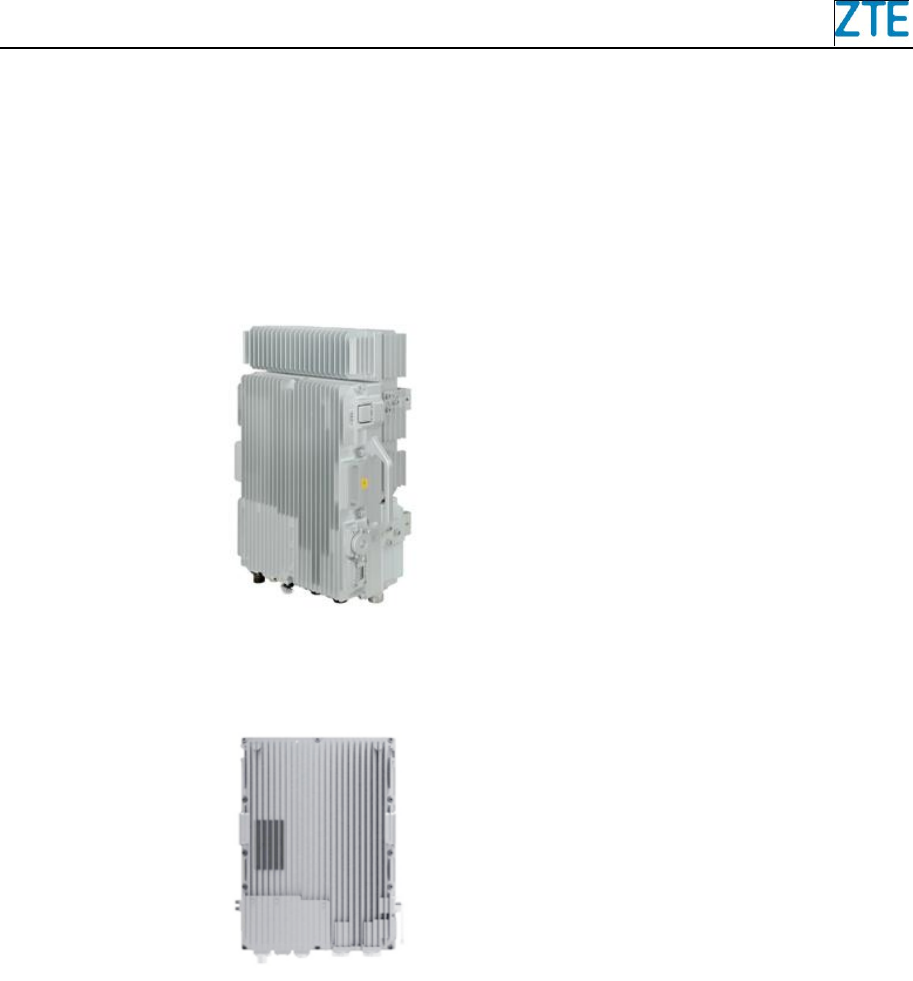
ZXSDR R8882 Product Description
6 ZTE Confidential & Proprietary
The differences between 2T2R and 2T4R modules include working bandwidth and
number of receivers. In the physical appearance, R8882 2T4R has four antenna feeder
interfaces but R8882 2T2R has two. The physical appearance is shown as follows.
Figure 2-1 R8882 (2*60W) Physical Appearance
Figure 2-2 R8882 (2*40W) Physical Appearance
R8882 has two PAs, with both PAs working on the same bands, or one PA in 900MHz
and the other in 1800MHz. With SDR platform, R8882 supports GSM, UMTS or LTE
single mode or mixed-mode through software configuration.
2.2 Hardware Structure
R8882 includes the following main hardware modules:
Quad-channel Transceiver (QTR) or Dual-channel Transceiver (DTR)
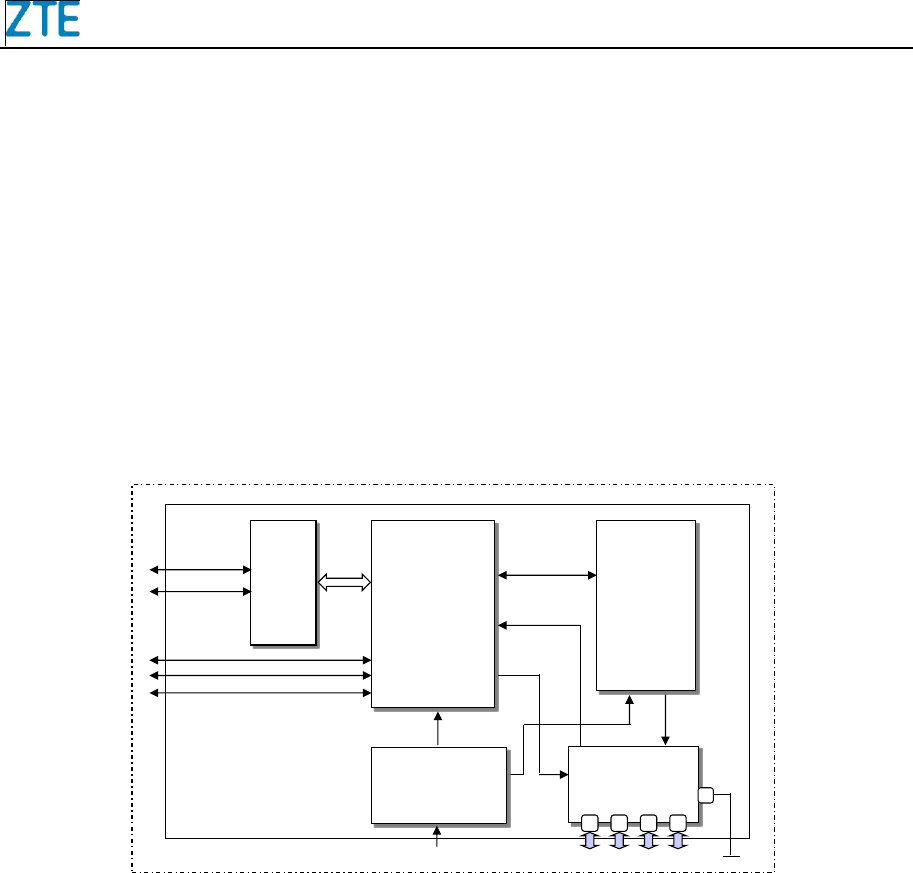
ZXSDR R8882 Product Description
ZTE Confidential & Proprietary 7
Duplex Filters (DFL)
2 * Power Amplifier (PA)
RRU Power for DC (RPDC)
Lightning protection module(PIB)
The hardware structure of R8882 is shown below.
Figure 2-3 R8882 System Structure
Optional*: For R8882 2T2R, ANT2 and ANT3 interfaces do not exist.
2.2.1 QTR/DTR
The QTR/DTR module has following functions:
QTR processes 4 received signals and 2 transmitted signals
DTR processes 2 received signals and 2 transmitted signals
Processes radio signal Up/Down conversion
Processes Downlink IQ signal multiplexing and uplink signal de-multiplexing
Processes signal amplifying, filtering, A/D conversion and D/A conversion
QTR/DTR
RPDC DFL
CPRI 1
CPRI 2
DC in ANT1 ANT2* ANT3* ANT4
2×PA
PA Out
AISG PIB
R8882
LMT
GND
MON

ZXSDR R8882 Product Description
8 ZTE Confidential & Proprietary
Converts between optical and electric signals
Captures reference clock signals from baseband unit and provide clock signals to
other units
Supports Voltage Standing Wave Ratio (VSWR) measurement and report;
Communicates with baseband unit and cascading RRU
Supports radio frequency hopping function
Supports adaptive modulation rate processing
Supports hardware failure self-detection and alarm
Supports over-heat detection and alarming
Provides communication interfaces, including,
Two CPRI interfaces
One RS485 serial port for external monitor equipment communication
One AISG for electrical tilt antenna, and
One Fast Ethernet port for LMT
Supports reset function
2.2.2 DFL
The DFL module includes 2 duplexers and 4 (or 2) receiving filters and has the following
functions:
Transmits and receives uplink and downlink signals in duplex mode
Suppresses spurious emission on the downlink to get acceptable out-band T
spurious emission required by the system and related protocol
Suppresses interference signals on the uplink to achieve a satisfied noise
coefficient

ZXSDR R8882 Product Description
ZTE Confidential & Proprietary 9
2.2.3 PA
There are 2 PAs and 4 (or 2) LNAs included and following functions are provided:
Amplifies downlink radio signals received from the TRM, and outputs the amplified
signals to the FLD
Amplifies four signals received from the FLD with the LNA, and then sends the
amplified signals to the TRM
Provides a pre-distortion feedback interface to the TRM
Provides an interface to the TRM for Voltage Standing Wave Ratio (VSWR)
detection (forward power detection)
Supports separate switch-off
Supports Inner-module temperature detection
Provides read and write interfaces for module inventory management
2.2.4 RPDC
The RPDC module has following functions:
Provides the built-in lightning protection for -48 V power supply
Provides -48 V power filter
Protects AISG signals (half-duplex 485 signal)
Protects the RS485 monitoring signals
Provides adaptation for external MON interface, AISG interface, and power
interface
Provides the hardware version identifiers of boards
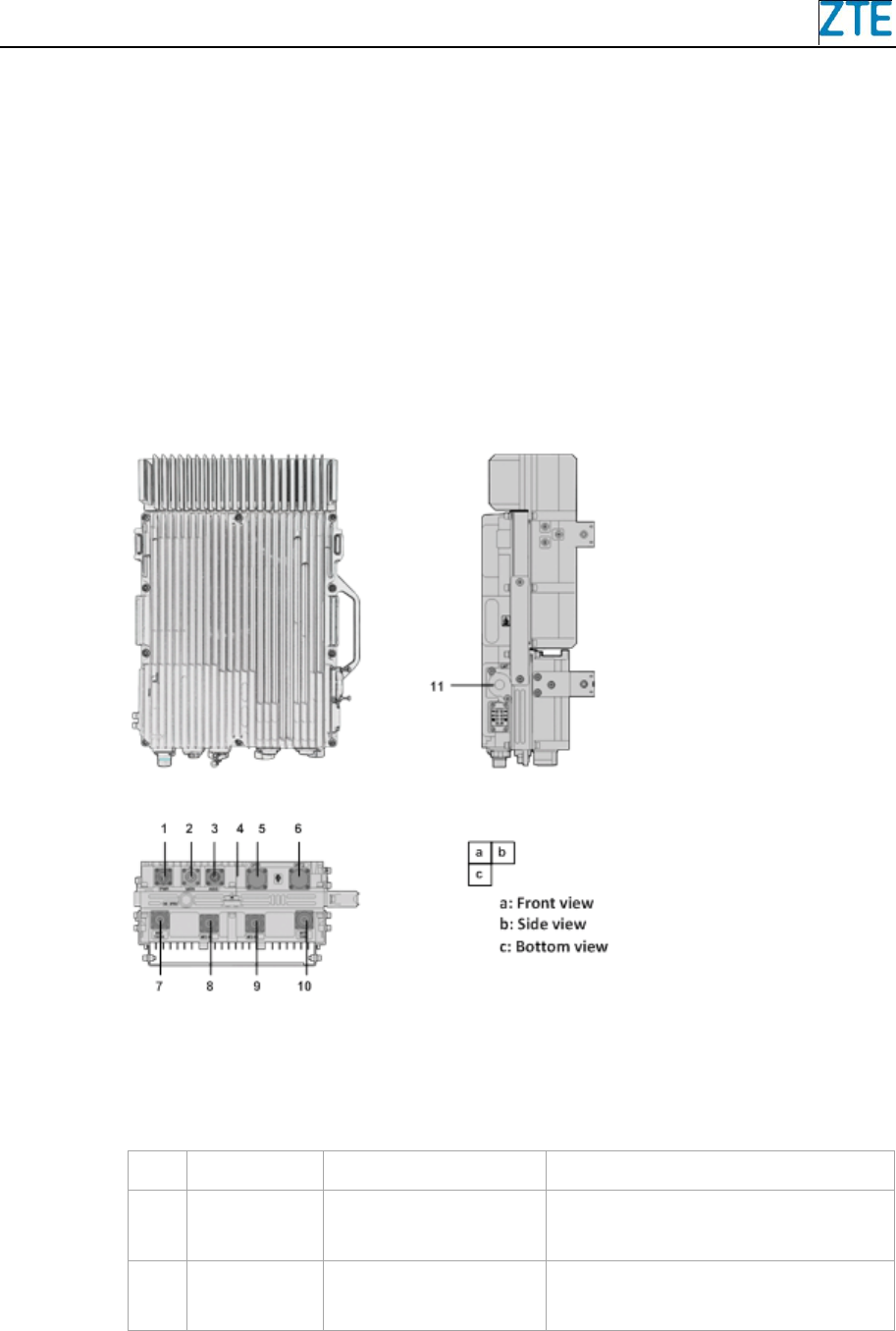
ZXSDR R8882 Product Description
10 ZTE Confidential & Proprietary
2.2.5 PIB
Provides lightning protection for the AISG, RS485 and dry contacts
2.3 External Interfaces
R8882 external interfaces are located at the bottom and side, as shown in Figure 2-4.
Figure 2-4 R8882 External Interfaces
The interfaces are described in the following table.
Table 2-1 R8882 External Interfaces Description
S.N.
Label
Interface
Interface Type/Connector
1
PWR
-48V DC power input
interface
2-pin round plastic connector (male)
2
MON
External monitoring
interface
8-pin circle connector (male)
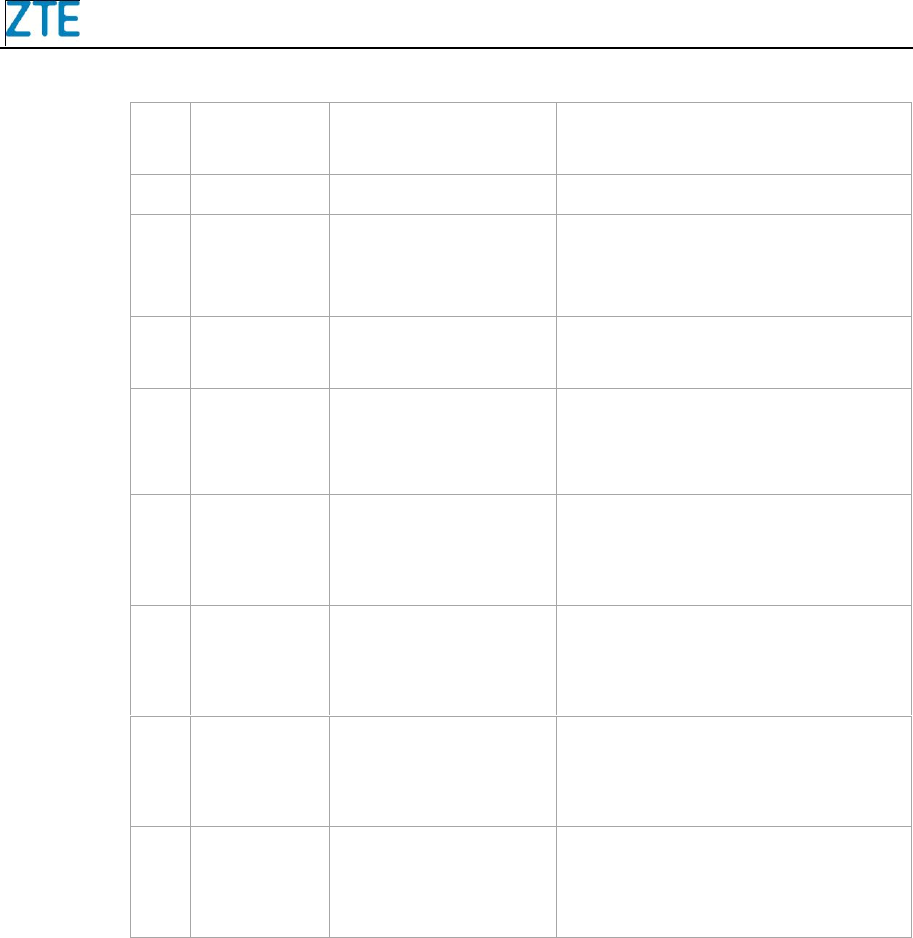
ZXSDR R8882 Product Description
ZTE Confidential & Proprietary 11
3
AISG
AISG interface
8-pin circle connector (IEC
60130-9-ED) (female)
4
GND
PE interface
16 mm2 yellow-green round terminal
5
OPT1
BBU and RRU
Interface/RRU
cascading interface
LC-mode optical interface (IEC 874)
6
OPT2
RRU cascading
interface
LC-mode optical interface (IEC 874)
7
ANT1
(TX0/RX0)
Antenna feeder
interface
(Tx0/Rx0)
50 Ω DIN-mode connector
8
ANT2
(RX2)
(Optional*)
Antenna feeder
interface (Rx2)
50 Ω DIN-mode connector
9
ANT3
(RX3)
(Optional*)
Antenna feeder
interface (Rx3)
50 Ω DIN-mode connector
10
ANT4
(TX1/RX1)
Antenna feeder
interface
(Tx1/Rx1)
50 Ω DIN-mode connector
11
LMT
Ethernet interface
for operation and
maintenance
RJ45
Optional*: For R8882 2T2R, ANT3 and ANT2 interfaces do not exist.
R8882 S8000 and S7200 has 2T2R only, and the other modules has
2.4 Software Architecture
The software architecture of R8882 can be divided into two layers: SDR Unified Platform
Software and Application Software. The architecture is shown in the following figure.
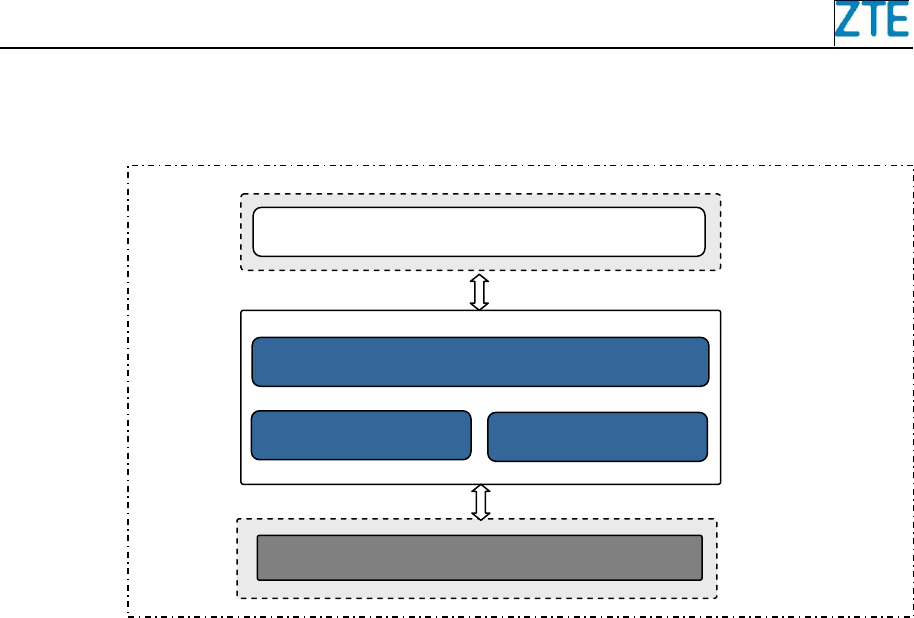
ZXSDR R8882 Product Description
12 ZTE Confidential & Proprietary
Figure 2-5 ZXSDR R8882 Software Architecture
The Operating and Maintenance (OAM) sub-system is the application layer. Its main
functions include software downloading, configuration, management, system
maintenance and measurement.
The Operation Support Sub-system (OSS) is the supporting layer in this entire
framework. It is a hardware independent layer that provides basic functions like
scheduling, timer, and memory management, communication, sequencing control,
monitoring, alarming and logging.
The Board Support Package (BSP) provides device driver & initialization and supports
basic functions like alarming and monitoring. It also provides related interfaces and
services to the Operating System.
2.5 Functionality
R8882 supports the following functionalities:
Supports DD/2600MHz by R8882 2*40W
Supports APAC700M/810M/850M/900M/1700M/1800M/1900M/2100MHz by
R8882 2*60W
Hardware
BSP
OSS
Linux
OAM
SDR Unified
Platform
Software
Application
Software
Hardware
System

ZXSDR R8882 Product Description
ZTE Confidential & Proprietary 13
Support the LTE scalable bandwidth configurations of 1.4MHz/3MHz/5MHz/10MHz/
15MHz/20MHz
Support 2T2R/2T4R in one box which can optimize spectrum efficiency greatly and
improve network uplink performance
supports two cells configuration with 2T4R module
Supports 2*2 MIMO configuration
Supports GSM only, UMTS only, LTE only or mixed mode
Support 64QAM modulation in both downlink and uplink for LTE
Supports RTWP report interval at 100ms and 2ms
Supports transmit power reporting function for every carrier
Supports overload protection function for power amplifier
Supports measurement, compensation and adjustment function for channel delay
Supports dynamic PA voltage adjustment to achieve best efficiency in different
system loads
Supports transmitting channel switching on/off function
Supports built-in lightning protection function for DC power supply
Supports no affect to the running of BBU and other R8882s that are connected to
the failure R8882
3 Technical Specifications
3.1 Physical Indices
R8882 employs the compact design, and the physical indices are listed below.
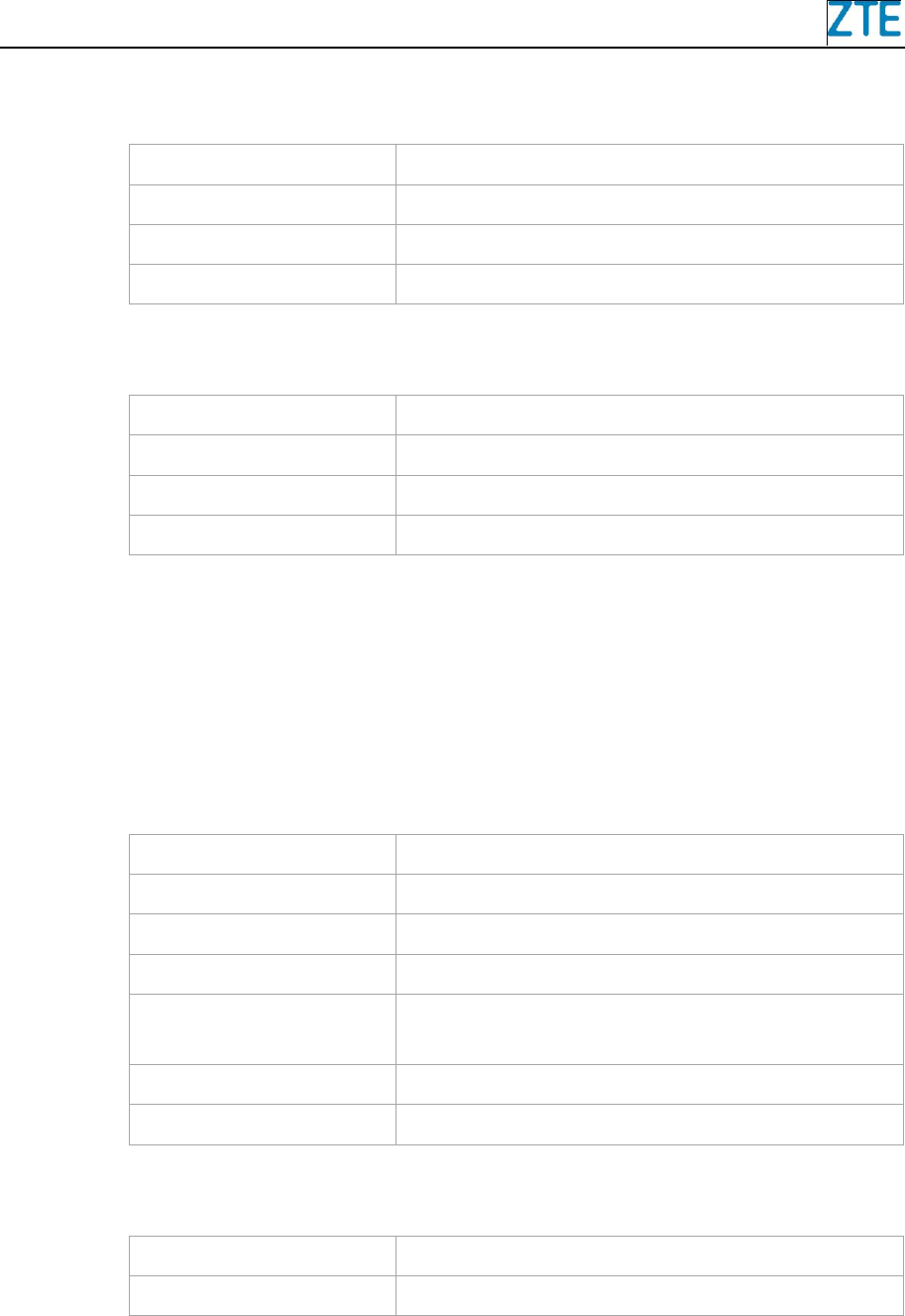
ZXSDR R8882 Product Description
14 ZTE Confidential & Proprietary
Table 3-1 R8882 (2*60W) Physical Indices
Item
Index
Dimension (H*W*D)
480*320*150 mm (23L)
Weight
23kg
Color
Silver gray
Table 3-2 R8882 (2*40W) Physical Indices
Item
Index
Dimension (H*W*D)
380*320*140 mm (17L)
Weight
20kg
Color
Silver gray
3.2 Performance Indices
3.2.1 Operation Frequency Band
Table 3-3 R8882 (2*60W) Frequency Spectrum
System
RRU Frequency Spectrum(MHz)
GSM single mode
850/900/1800/1900
UMTS single mode
850/900/1700/1900/2100
LTE single mode
APAC700/810/850/900/1700/1800/1900/2100
GU Dual-Mode
850/900/1900, or GU Dual-Mode in 900MHz of one PA,
and GSM single mode in 1800MHz of the other PA
GL Dual-Mode
900/1800
UL Dual-Mode
1700/2100
Table 3-4 R8882 (2*40W) Frequency Spectrum
System
RRU Frequency Spectrum(MHz)
LTE single mode
DD/2600
Note: The actual working bandwidth and IBW are subject to the products configured.
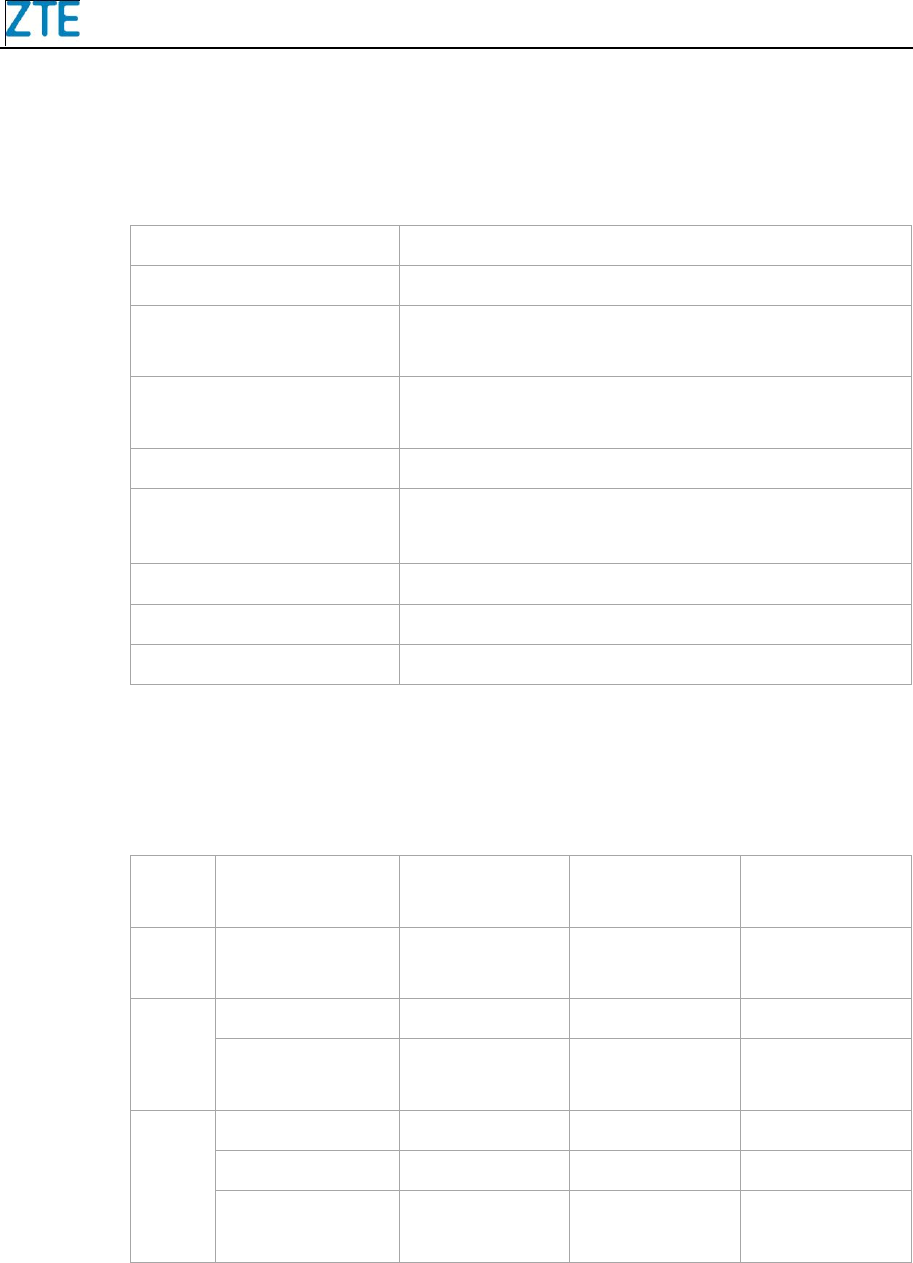
ZXSDR R8882 Product Description
ZTE Confidential & Proprietary 15
3.2.2 Capacity
Table 3-5 R8882 Capacity
System
RRU Capacity
GSM single mode
12 TRXs, or 6 TRXs@900MHz + 6 TRXs@1800MHz
UMTS single mode(except
1700MHz)
8 carriers (non-MIMO), or 4 carriers (MIMO)
UMTS single
mode(1700MHz)
2 UMTS carriers (MIMO)
LTE single mode
1.4MHz, 3MHz, 5MHz, 10MHz, 15MHz and 20MHz
GU Dual-Mode
8 GSM TRXs + 2 UMTS carriers, or
4 GSM TRXs + 4 UMTS carriers
GL Dual-Mode 900MHz
8 GSM TRXs + LTE10MHz
GL Dual-Mode 1800MHz
8 GSM TRXs + LTE 20MHz
UL Dual-Mode
2 UMTS carriers (MIMO) + LTE 20MHz
3.2.3 Static Receiving Sensitivity
Table 3-6 R8882 Static Receiver Sensitivity
Mode
Frequency
Spectrum(MHz)
Single Antenna
(dBm)
Dual Antennas
(dBm)
Four Antennas
(dBm)
GSM
850/900/1800/
1900
-113.5
-115.5
N/A
UMTS
2100
-126.5
-129.2
N/A
850/900/1700/190
0
-126.4
-129.1
N/A
LTE
APAC700/DD
-106.6
-109.4
N/A
850/900
-106.6
-109.4
-112.2
1700/1800/1900/2
100/2600
-106.4
-109.2
-112
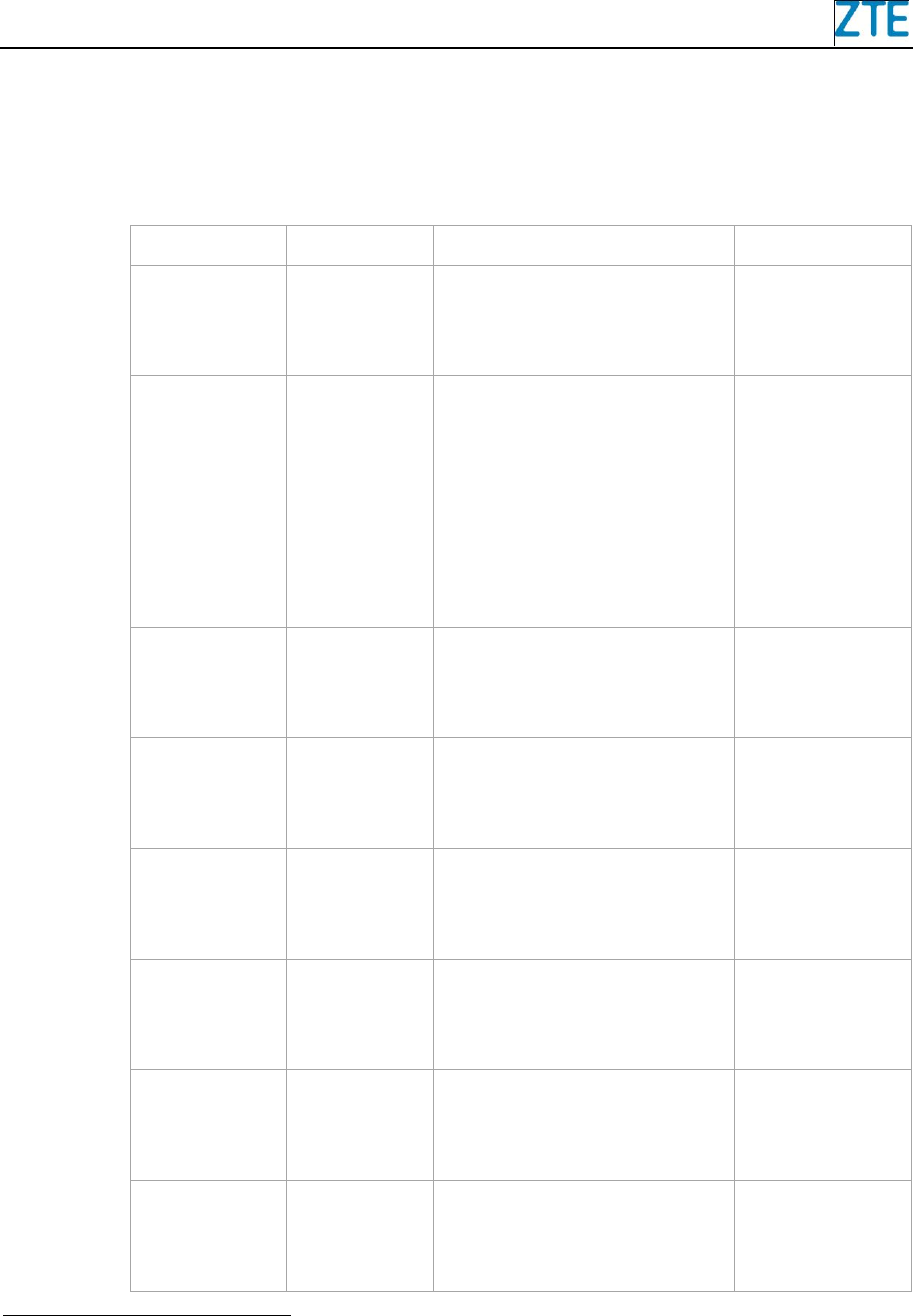
ZXSDR R8882 Product Description
16 ZTE Confidential & Proprietary
3.2.4 TOC Output Power
Table 3-7 R8882 TOC Output Power and Transmitting & Receiving Channels
Type
TOC [1]
Working Frequency Band
2T2R or 2T4R [2]
R8882 S9000
2*60W
B8
TX: 925 MHz - 960 MHz
RX: 880 MHz - 915 MHz
2T4R/2T2R
R8882 S1800
2*60W
B3
Type1:
TX: 1805MHz - 1860MHz
RX: 1710MHz - 1765MHz
Type2:
TX: 1825MHz - 1880MHz
RX: 1730MHz - 1785MHz
2T4R/2T2R
R8882 S2100
2*60W
B1
TX: 2110MHz - 2170 MHz
RX: 1920MHz - 1980 MHz
2T4R/2T2R
R8882 S2600
2*40W
B7
TX: 2620MHz -2690MHz
RX: 2500MHz -2570MHz
2T4R/2T2R
R8882 S8500
2*60W
B5
TX: 869MHz - 894MHz
RX: 824MHz - 849MHz
2T4R/2T2R
R8882 S1900
2*60W
B2
TX: 1930MHz - 1990MHz
RX: 1850MHz - 1910MHz
2T4R/2T2R
R8882 S7200
(APAC 700)
2*60W
B28
TX: 758MHz - 803MHz
RX: 703MHz - 748MHz
2T2R
R8882 S8000
(DD)
2*40W
B20
TX: 791MHz - 821MHz
RX: 832MHz - 862MHz
2T2R
1 The TOC here means the max capacity. The specific TOC would be limited by the license.
2 2T means 2-antenna transmission; 2R means 2-antenna reception; and so on.
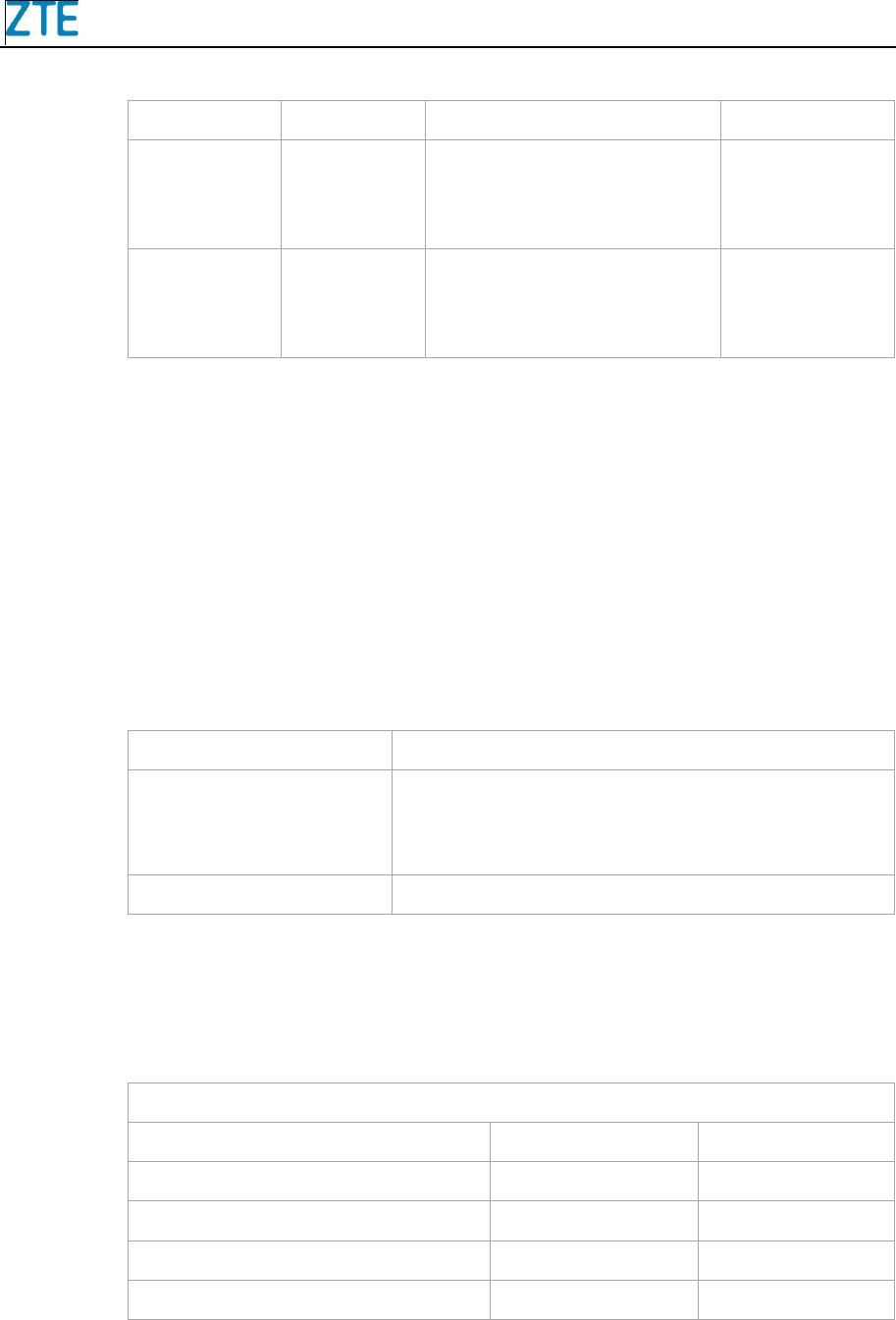
ZXSDR R8882 Product Description
ZTE Confidential & Proprietary 17
Type
TOC [1]
Working Frequency Band
2T2R or 2T4R [2]
R8882 S8100
2*60W
B27
TX: 851MHz - 869MHz
RX: 806MHz - 824MHz
2T4R/2T2R
R8882 S1700
(AWS)
2*60W
B4
TX: 2110 MHz - 2155 MHz
RX: 1710 MHz - 1755 MHz
2T4R/2T2R
Note: When “ZGO-04-01-011 Power Boost for 8PSK” is applied in GSM mode, the TOC output
power achieves the same in 8PSK modulation as in GMSK.
3.3 Power Indices
3.3.1 Power Supply
Table 3-8 R8882 Power supply indices
Module
Input Power
R8882 (2*60W)
DC: -48 V (-37 V–-60 V DC)
AC: 110 V/220 V (90 V–290 V AC) (by AC/DC
lightning protection unit)
R8882 (2*40W)
DC: -48 V (-37 V–-60 V DC)
3.3.2 Power Consumption
Table 3-9 R8882 Power Consumption in UMTS Single Mode
Configuration: S2/2, 2PA, TOC 20W/UMTS carrier
Module
Average PC (W)
Peak PC (W)
R8882 S9000
240
345
R8882 S2100
210
320
R8882 S8500
195
290
R8882 S1900
275
410
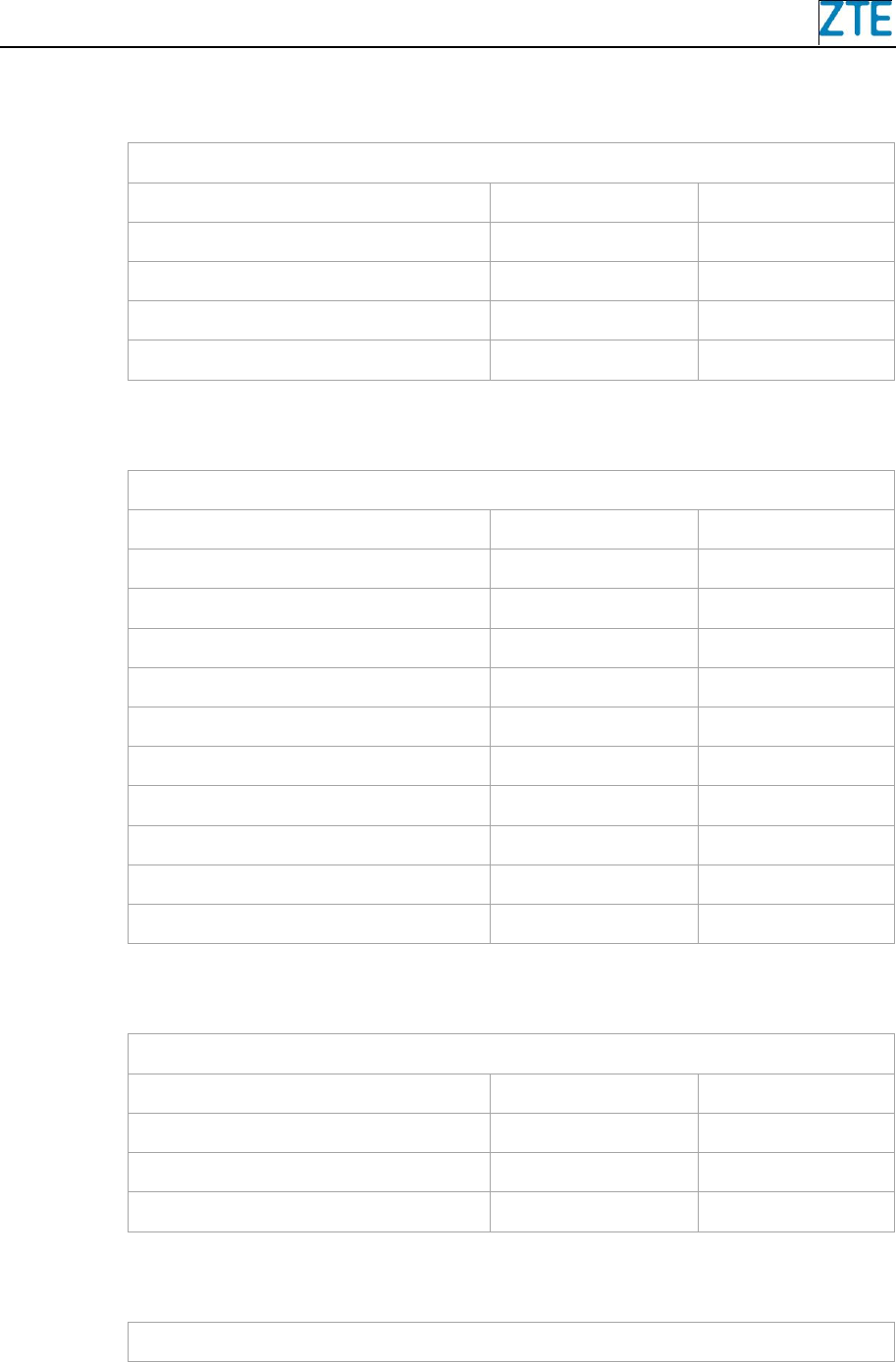
ZXSDR R8882 Product Description
18 ZTE Confidential & Proprietary
Table 3-10 R8882 Power Consumption in GSM Single Mode
Configuration: S4/4, 2PA, TOC 15W/GSM TRX
Module
Average PC (W)
Peak PC (W)
R8882 S9000
290
445
R8882 S1800
280
455
R8882 S8500
240
395
R8882 S1900
320
515
Table 3-11 R8882 Power Consumption in LTE Single Mode
Configuration: LTE single carrier, 2PA, 60W/LTE
Module
Average PC (W)
Peak PC (W)
R8882 S8000 (DD)
185
315
R8882 S2600
215
385
R8882 S7200 (APAC 700)
230
440
R8882 S8100
230
440
R8882 S8500
230
440
R8882 S9000
230
440
R8882 S1800
275
485
R8882 S1900
275
485
R8882 S1700
285
505
R8882 S2100
285
505
Table 3-12 R8882 Power Consumption in GSM/UMTS Dual-Mode
Configuration: 8G2U, TOC 10W/GSM TRX+ 20W/UMTS carrier
Module
Average PC (W)
Peak PC (W)
R8882 S9000
300
445
R8882 S8500
250
395
R8882 S1900
335
515
Table 3-13 R8882 Power Consumption in GSM/LTE Dual-Mode
Configuration: 8G1L, 2PA, TOC 10W/GSM TRX+20W/LTE
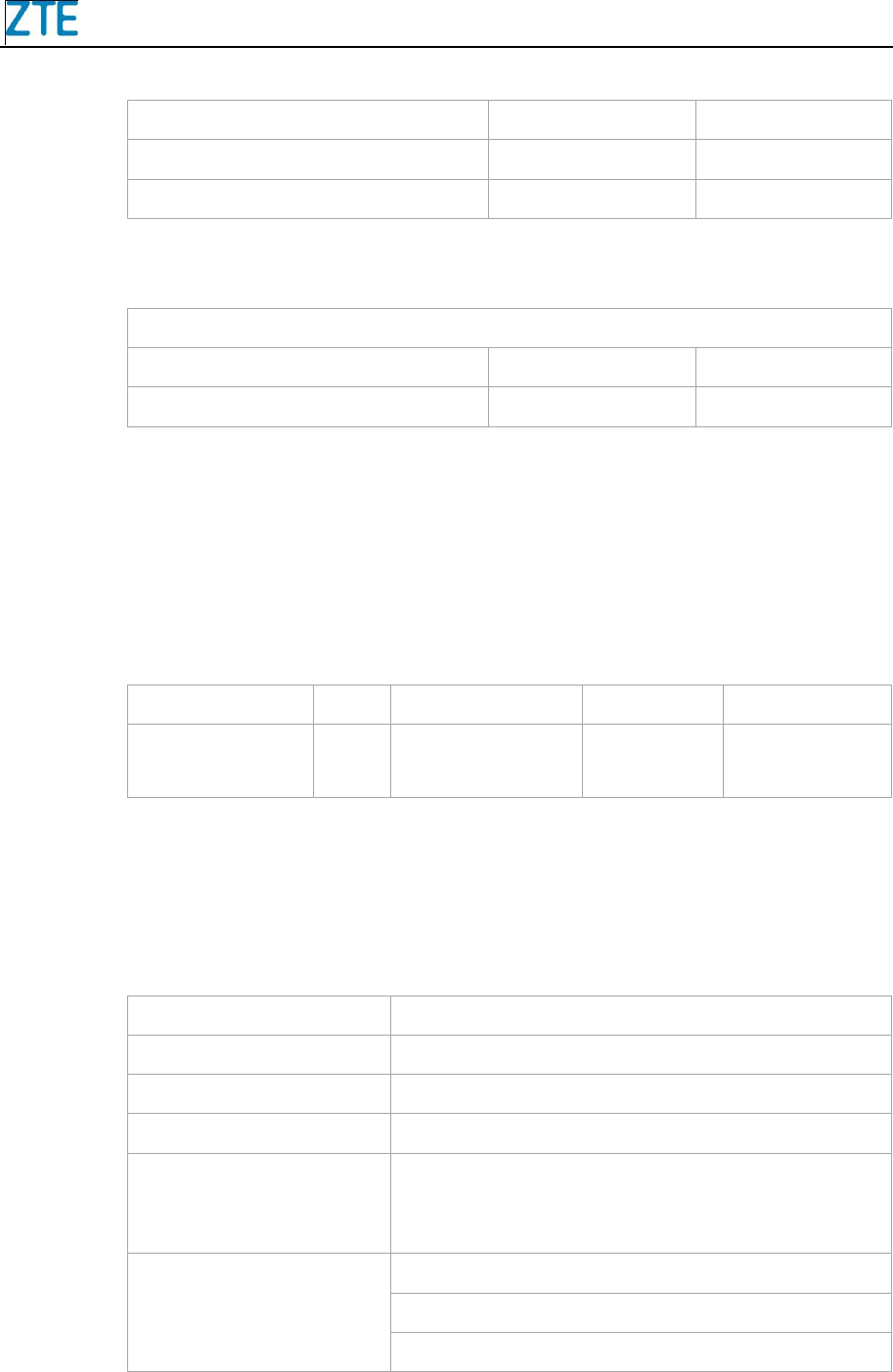
ZXSDR R8882 Product Description
ZTE Confidential & Proprietary 19
Module
Average PC (W)
Peak PC (W)
R8882 S9000
350
485
R8882 S1800
345
475
Table 3-14 R8882 Power Consumption in UMTS/LTE Dual-Mode
Configuration: 2U1L, TOC 20W/UMTS carrier+20W/LTE
Module
Average PC (W)
Peak PC (W)
R8882 S2100
300
505
3.4 Transmission
R8882 is connected to BBU through CPRI interfaces.
Table 3-15 R8882 CPRI Interfaces
Item
Value
Interface Kind
Speed
Standard
CPRI interface
2
SFP (LC)
2.4576Gbps
3.072Gbps
CPRI V4.2
3.5 Working Environment
Table 3-16 R8882 Environment Condition Compatibility
Item
Index
Temperature
-40 - +55 °C
Relative humidity
5% - 95%
Waterproof/dustproof
IP65
Ground
≤5 Ω; earth resistance can be less than 10 Ω in
thunder-less area where there less than 20
thunderstorm days per year.
Storage
Indoor pack deposited
Temperature: -40 °C to 70 °C
Relative Humidity: 5% to 100%
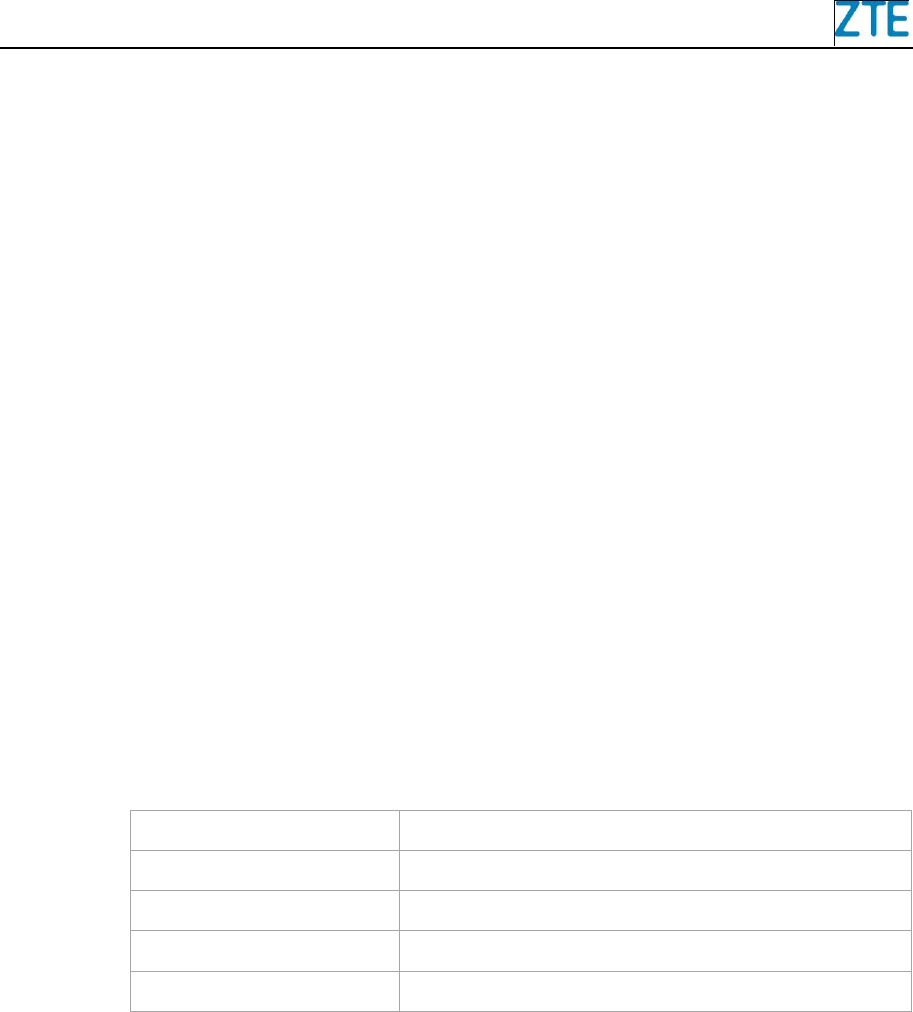
ZXSDR R8882 Product Description
20 ZTE Confidential & Proprietary
3.6 Electromagnetic Compatibility
YD/T 1595.2-2007
ETSI EN 301 489-01, ETSI EN 301 489-23
ETSI EN 300 386–V1.3.2
(CISPR22) Class B
Directive 1999/5/EC (R&TTE)
3.7 Reliability
In R8882, the algorithm of system reliability conforms to the national military GJB/Z299B
Electronic Equipment Reliability Estimation Manual and US military handbook
MIL-HDBK-217F Electronic Equipment Reliability Estimation.
Table 3-17 R8882 Reliability Characteristics
Item
Index
MTBF
≥464,000 hours
MTTR
1 hour
Availability index
≥99.999784%
Down duration
≤1.133 min/year
4 Installation
R8882 is easy to be deployed.
It is portable for transportation and flexible installation on the pole, tower and
against wall.
Only fibers, power cables, RF cable antennas, PE and AISG cables need to be
connected.

ZXSDR R8882 Product Description
ZTE Confidential & Proprietary 21
It is suitable for any weather condition with IP65 water resistance and dust proof
case.
5 Configurations
R8882 can be configured as GSM, UMTS, LTE single mode or mixed mode through
software. By choosing different frequencies and software configurations, R8882 can
support various GSM/UMTS/LTE configurations. Both R8882 2T4R and 2T2R modules
support 2*2 MIMO, and R8882 2T4R supports two cells with 1T2R for each cell.
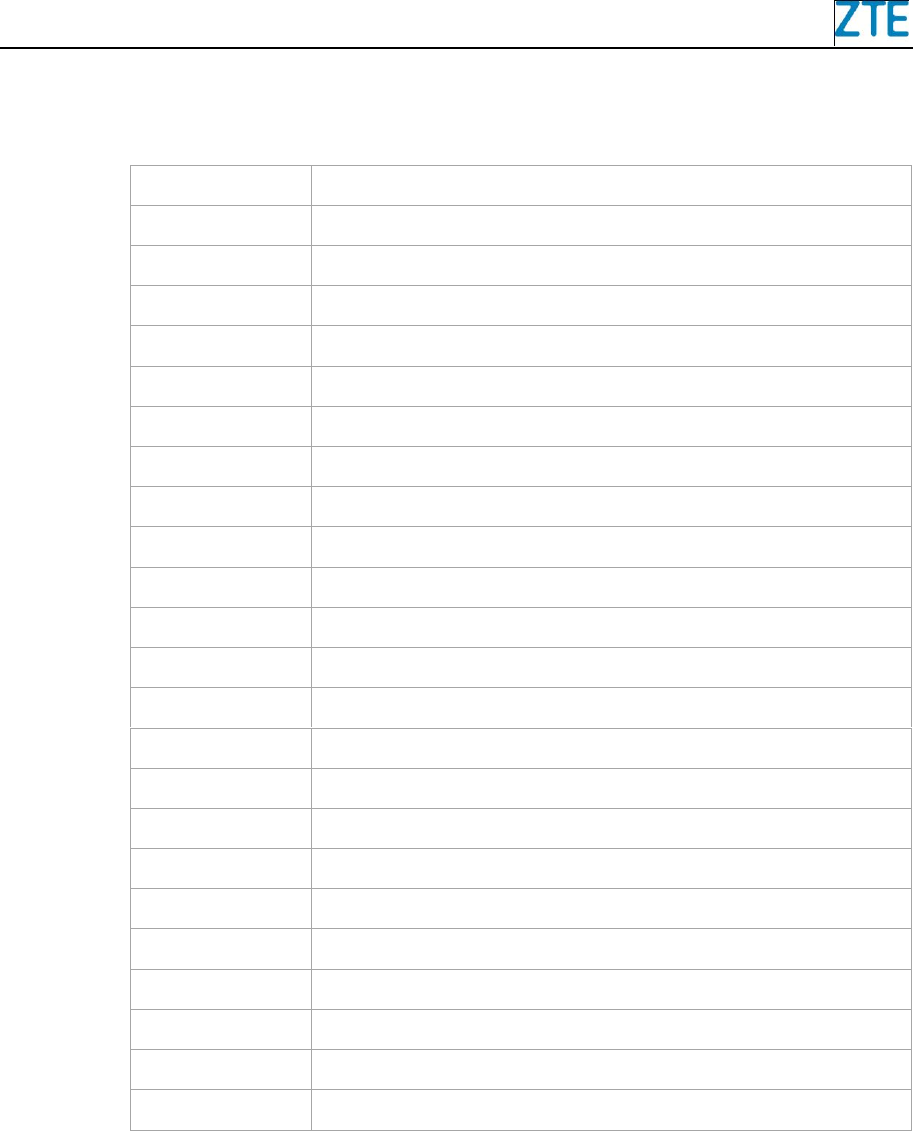
ZXSDR R8882 Product Description
22 ZTE Confidential & Proprietary
6 Abbreviation
Abbreviation
Full Characters
BBU
Base Band processing Unit
BRACS
Barrier Access Control Sub-system
BRS
Barrier Sub-system
BSP
Board Support Package
CAPEX
Capital Expenditure
CPRI
Common Public Radio Interface
DBS
Data Base Sub-system
GSM
Global System for Mobile communications
LMT
Local Maintenance Terminal
LTE
Long Term Evolution
MIMO
Multi Input Multi Output
MTBF
Mean Time Between Failures
MTTR
Mean Time To Recovery
OAM
Operating And Maintenance
OPEX
Operation Expenditure
OSS
Operation Support Sub-system
RF
Radio Frequency
RRU
Remote Radio Unit
RTWP
Received Total Wideband Power
SCS
System Control Sub-system
SDR
Software Defined Radio
UE
User Equipment
UMTS
Universal Mobile Telecommunications System